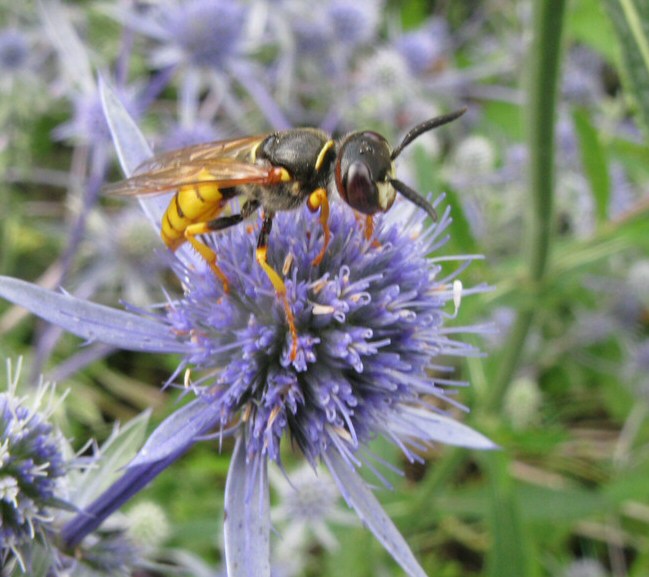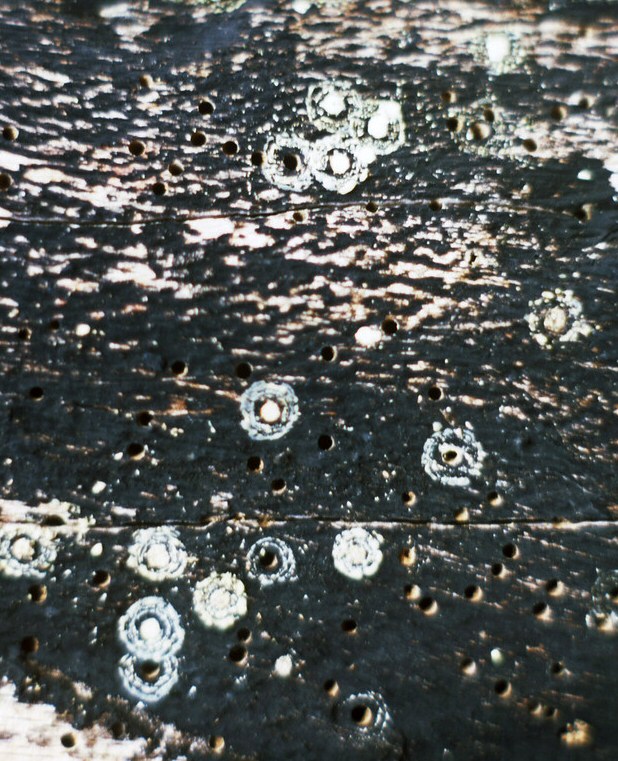- Home
- Garden Wildlife
- Insects
- Hymenoptera
- Solitary wasps
Above left: a species of Ectemnius a genus of solitary wasp, from which Jennifer Owen found 5 species in her garden.
Above right: nests of a crabronid wasp, Passaloecus eremita, in woodworm tunnels, some completed and sealed with pine resin.
The adults of some solitary wasp species will visit flowers to feed on nectar and pollen. Some female solitary wasps are capable of stinging people if roughly handled, but use of the sting is normally confined to subduing the insects and spiders collected to stock the wasps’ nests.
Life cycle
Spider wasps lay a single egg on each stored spider, on which the wasp larva will subsequently feed. Other solitary wasps also have larvae that feed on the food insects or spiders provided by the mother wasp. When fully fed, solitary wasp larvae spin silk cocoons and pupate within the nest. There is usually one generation a year, overwintering as pupae and emerging as adult wasps in the following summer.
Role of solitary wasps in gardens
Some of the insects collected to provision nests, such as aphids, leafhoppers and caterpillars are potential pests of garden plants. A crabronid wasp, Cerceris arenaria, stocks its nests with adult vine weevils, which is a great help to gardeners. However, some solitary wasps collect hoverfly species that have larvae that prey on aphids, so the overall benefit in terms of reducing pest insects may be limited.
Other sources of information
Websites
Website of the Bees, Wasps and Ants Recording Society (BWARS)
Books
Yeo, P and Corbet S. (2015) Solitary Wasps. Naturalists Handbooks 3 Pelagic Publishing
Archer, M. E. (2000) The British potter and mason wasps: Key. BWARS Available as a free download
Archer, M. E. (2014) Handbooks for the Identification of British Insects Vol 6 part 6 The vespoid wasps (Tiphiidae, Mutillidae, Sapygidae, Scoliidae and Vespidae) of the British Isles. Royal Entomological Society
Day, M. C. (1988) Handbooks for the Identification of British Insects Vol 6 part 4. Spider wasps Hymenoptera: Pompilidae available as a free download
Morgan, D. (1984) Handbooks for the Identification of British Insects Vol 6 part 5. Cuckoo wasps Hymenoptera, Chrysididae available as a free download
Richards, O. W. (1980) Handbooks for the Identification of British Insects Vol 6 part 3b Scolioidea, Vespoidea and Sphecoidea Hymenoptera, Aculeata. Royal Entomological Society available as a free download
Yeo, P. F. & Corbet, S. A. (1983) Naturalists' Handbooks 3 Solitary wasps. Richmond Publishing
By Andrew Halstead reviewed by Andrew Salisbury edited by Steve Head


,_Texel,_the_Netherlands.jpg)
Solitary wasps
As the name implies, solitary wasps do not have a social organisation. Each female acts on her own in constructing and provisioning her nest, without the assistance of a worker caste. Solitary wasps belong to several families within the Hymenoptera Order. These include the Pompilidae or spider wasps, the Chrysididae, jewel or cuckoo wasps, and other solitary wasps in the Vespidae, Crabronidae and Sphecidae families.
Species in Britain and Ireland
We have 45 species of spider wasps, 33 jewel wasps, 22 vespid solitary wasps, seven sphecid solitary wasps, and 124 crabronid solitary wasps. Some are rare or confined to restricted habitats but some are common in gardens. Jennifer Owen found 55 species in her Leicester garden, the commonest being Passaloecus singularis, which feeds on wingless aphids.
Biology
Spider wasps have relatively long slender legs and move quickly in a jerky fashion. They are mostly black or black with a reddish band on the abdomen. Most spider wasps provision their nests with spiders, which the female wasp paralyses with her sting. The comatose spider is then dragged back to the wasp’s nest, which may be a tunnel in the soil, in a hollow plant stem, a crevice in bark, or in beetle tunnels in dead wood. Some spider wasps, such as Evagates species, behave like cuckoos and enter the nests of other spider wasps to lay their eggs on the spiders stored by the host spider wasp.
Episyron rufipes, a typical Pompilid spider wasp
![Photo: Alvesgaspar [CC BY-SA 3.0 (https://creativecommons.org/licenses/by-sa/3.0)]](images/800px-Chrysis_April_2008-1.jpg)
Cuckoo or Jewel wasps, sometimes also known as ruby-tailed wasps, enter and lay eggs in the nests of other solitary wasps and bees, where their larvae first eat the host larva or eggs and then feed on food stored for the larvae of the host wasp or bee. This habit of stealing food is called kleptoparasitism. Jewel wasps are distinctive because of their iridescent red, green, blue or violet colour, or combinations of these colours.
Chyrsis ignita a chrysidid jewel wasp recorded by Jennifer Owen in her garden study
Other solitary wasps are black or black with yellow or reddish brown markings. They make their nest tunnels in the soil, in hollow plant stems, in rotten wood, or they use beetle tunnels in dead wood. They provision their nests with spiders or insects such as caterpillars, aphids, leafhoppers, flies and beetles to provide food for the larvae. The type of insect or spider used to stock the nest depends on the species of solitary wasp.
The bee wolf wasp Philanthus triangulum is a very large crabronid (hornet-related) wasp that used to be extremely scarce in Britain, but has expanded greatly in range and numbers. It preys on honeybees, and while making solutary nests in sandy banks, often is found in very large aggregations.
This is a species likely to be increasingly often seen in gardens. It is not considered a threat to honeybees as it is active in late summer when there are plenty of honeybees available.
![Photo: gailhampshire from Cradley, Malvern, U.K [CC BY 2.0 (https://creativecommons.org/licenses/by/2.0)]](images/800px-Ectemnius_species_(39497905651).jpg)
Solitary wasps
As the name implies, solitary wasps do not have a social organisation. Each female acts on her own in constructing and provisioning her nest, without the assistance of a worker caste. Solitary wasps belong to several families within the Hymenoptera Order. These include the Pompilidae or spider wasps, the Chrysididae, jewel or cuckoo wasps, and other solitary wasps in the Vespidae, Crabronidae and Sphecidae families.
Species in Britain and Ireland
We have 45 species of spider wasps, 33 jewel wasps, 22 vespid solitary wasps, seven sphecid solitary wasps, and 124 crabronid solitary wasps. Some are rare or confined to restricted habitats but some are common in gardens. Jennifer Owen found 55 species in her Leicester garden, the commonest being Passaloecus singularis, which feeds on wingless aphids.
Biology
Spider wasps have relatively long slender legs and move quickly in a jerky fashion. They are mostly black or black with a reddish band on the abdomen. Most spider wasps provision their nests with spiders, which the female wasp paralyses with her sting. The comatose spider is then dragged back to the wasp’s nest, which may be a tunnel in the soil, in a hollow plant stem, a crevice in bark, or in beetle tunnels in dead wood. Some spider wasps, such as Evagates species, behave like cuckoos and enter the nests of other spider wasps to lay their eggs on the spiders stored by the host spider wasp.
,_Texel,_the_Netherlands.jpg)
Episyron rufipes, a typical pompilid spider wasp
Cuckoo or Jewel wasps, sometimes also known as ruby-tailed wasps, enter and lay eggs in the nests of other solitary wasps and bees, where their larvae first eat the host larva or eggs and then feed on food stored for the larvae of the host wasp or bee. This habit of stealing food is called kleptoparasitism. Jewel wasps are distinctive because of their iridescent red, green, blue or violet colour, or combinations of these colours.
![Photo: Alvesgaspar [CC BY-SA 3.0 (https://creativecommons.org/licenses/by-sa/3.0)]](images/800px-Chrysis_April_2008-1.jpg)
Chyrsis ignita a Chrysidid jewel wasp recorded by Jennifer Owen in her garden study


Other solitary wasps are black or black with yellow or reddish brown markings. They make their nest tunnels in the soil, in hollow plant stems, in rotten wood, or they use beetle tunnels in dead wood. They provision their nests with spiders or insects such as caterpillars, aphids, leafhoppers, flies and beetles to provide food for the larvae. The type of insect or spider used to stock the nest depends on the species of solitary wasp.
Above left: a species of Ectemnius a genus of solitary wasp, from which Jennifer Owen found 5 species in her garden.
Above right: nests of a crabronid wasp, Passaloecus eremita, in woodworm tunnels, some completed and sealed with pine resin.
The adults of some solitary wasp species will visit flowers to feed on nectar and pollen. Some female solitary wasps are capable of stinging people if roughly handled, but use of the sting is normally confined to subduing the insects and spiders collected to stock the wasps’ nests.
Life cycle
Spider wasps lay a single egg on each stored spider, on which the wasp larva will subsequently feed. Other solitary wasps also have larvae that feed on the food insects or spiders provided by the mother wasp. When fully fed, solitary wasp larvae spin silk cocoons and pupate within the nest. There is usually one generation a year, overwintering as pupae and emerging as adult wasps in the following summer.
Role of solitary wasps in gardens
Some of the insects collected to provision nests, such as aphids, leafhoppers and caterpillars are potential pests of garden plants. A crabronid wasp, Cerceris arenaria, stocks its nests with adult vine weevils, which is a great help to gardeners. However, some solitary wasps collect hoverfly species that have larvae that prey on aphids, so the overall benefit in terms of reducing pest insects may be limited.
Other sources of information
Websites
Books
Yeo, P and Corbet S. (2015) Solitary Wasps. Naturalists Handbooks 3 Pelagic Publishing
Archer, M. E. (2000) The British potter and mason wasps: Key. BWARS Available as a free download
Archer, M. E. (2014) Handbooks for the Identification of British Insects Vol 6 part 6 The vespoid wasps (Tiphiidae, Mutillidae, Sapygidae, Scoliidae and Vespidae) of the British Isles. Royal Entomological Society
Day, M. C. (1988) Handbooks for the Identification of British Insects Vol 6 part 4. Spider wasps Hymenoptera: Pompilidae available as a free download
Morgan, D. (1984) Handbooks for the Identification of British Insects Vol 6 part 5. Cuckoo wasps Hymenoptera, Chrysididae available as a free download
Richards, O. W. (1980) Handbooks for the Identification of British Insects Vol 6 part 3b Scolioidea, Vespoidea and Sphecoidea Hymenoptera, Aculeata. Royal Entomological Society available as a free download
Yeo, P. F. & Corbet, S. A. (1983) Naturalists' Handbooks 3 Solitary wasps. Richmond Publishing
By Andrew Halstead reviewed by Andrew Salisbury edited by Steve Head












